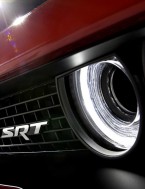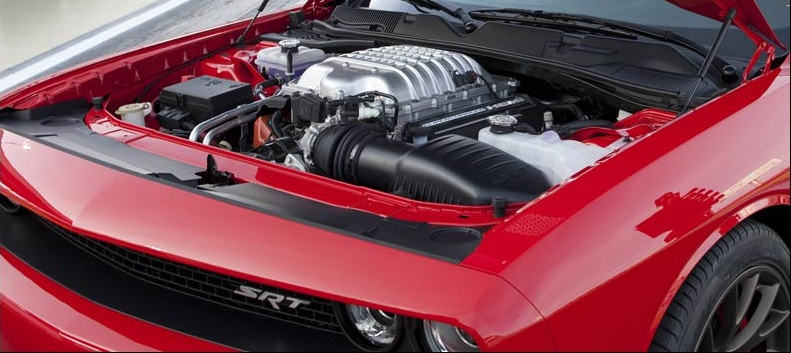
For the new engine in the 2015 Challenger SRT Hellcat, the supercharger supplier is not Eaton (which is famous for the Eaton TVS used on the Audi 3.0 V6 engine). Instead it is an twin screw supercharger from IHI.
The IHI supercharger has similar efficiency with the Eaton TVS roots-type superchargers, but it has a significant higher operation noise level, which I think is not a problem for the purpose of Challenger anyway – because the Challenger is not designed for luxury car purpose. And also I guess the invoice that IHI is quoting Chrysler may be lower than Eaton.
After the supercharger there is a huge pressure stabilization chamber similar to a naturally aspirated engine. The Hellcat engine also has two water-to-air intercoolers.
The Hellcat engine also keeps the HEMI family tradition of two spark plugs per cylinder. But it is a different design. In previous HEMI engines, the primary spark plug is driven by a coil-on-plug ignition coil; but the secondary spark plug on the same cylinder is not connect to the coil that controls the primary plug, instead it is connected to the coil which is on the opposed side cylinder’s primary spark plug. Therefore the wiring is an interlaced pattern.
Why Dodge designed the old HEMI ignition coil pattern like this? The reason is: the ignition timing between the two spark plugs on the same cylinder is extremely short. If a single ignition coil needs to drive those 2 plugs, it must be capable of ultra-high frequency firing. Apparently Dodge engineer did not solve this issue due to budget and cost constraint previously.
Now it looks like they have come out with a solution for the Challenger SRT Hellcat (by charging a higher MSRP maybe?), so on this new engine the two spark plugs are driven by the same ignition coil.
The cylinder block is still made with cast iron, bore is the same but stroke is shortened a little bit. The compression ratio is dropped to 9.5. This is clearly a disadvantage that not using fuel direct injection. Compared to Chevrolet’s LT4, they have the same displacement (6.2L), but LT4 can keep the 10.0 compression ratio and output 59 lb-ft more torque than the Hellcat, which max torque will be 575 lb-ft. (Update: Chrysler finally released specs for the engine, it has 707hp and 650 lb-ft of torque)
One more changes that the Hellcat engine has made is, the cylinder-deactivation feature is removed, which means all of the 8 cylinders will work full time for all the time.




Well,…you were sure way off by citing the torque lb.-ft. at 575.The official number is 650 lb.-ft. of torque.This is why we should always wait for the correct information to be officially released and not try to assume or speculate.
Mopar started firing both plugs from the same coil in 2009. Glad you stay current on subjects you right about